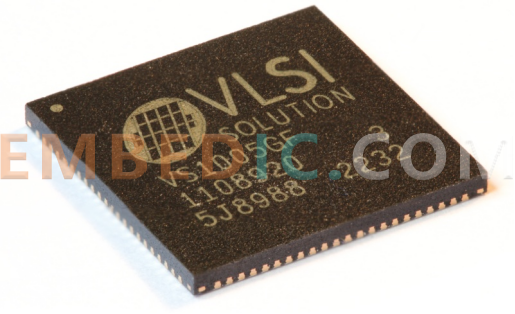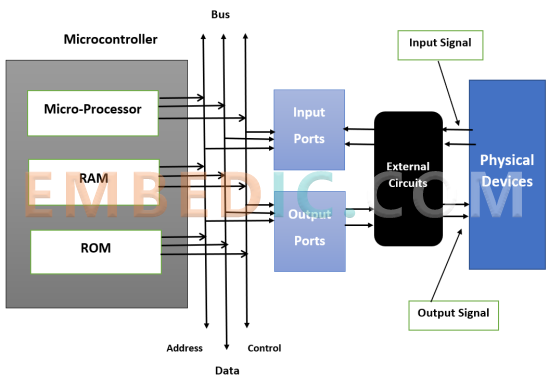Very Large Scale Integration Circuit (VLSI) is an integrated circuit that combines a large number of transistors into a single chip with a greater degree of integration than a large-scale integrated circuit. The number of transistors integrated varies in different standards.

The research and development of integrated circuits began in the 1970s with the development of complex semiconductors and communication technologies. The microprocessor, the control core of a computer, is the most typical example of a very large-scale integrated circuit. Very large-scale integrated circuit design (VLSI design), especially digital integrated circuits, is usually carried out by means of electronic design automation, which has become one of the important branches of computer engineering.
At present, the integration degree of ultra-large-scale integrated circuits has reached 6 million transistors, with a line width of 0.3 microns. Electronic devices made with ultra-large-scale integrated circuits are small, lightweight, low power consumption and highly reliable. The use of ultra-large-scale integrated circuit technology can be an electronic subsystem and even the entire electronic system "integrated" on a chip, complete information acquisition, processing, storage and other functions.
For example, the entire 386 microprocessor circuits can be integrated on a chip, the integration degree of 2.5 million transistors. Ultra-large-scale integrated circuits developed successfully, is a leap in microelectronics technology, greatly promoting the progress of electronic technology, thus driving the development of military and civilian technology. Ultra-large-scale integrated circuits have become an important symbol of a country's level of scientific and technological and industrial development, but also the world's major industrial countries, especially the United States and Japan, one of the most competitive areas.
"Superscale" is a phrase that's been around for years. The most advanced manufacturing processes are in the order of 7 nanometers, and most of the actual mass-produced processes are at 14 and 22 nanometers. In order of sales, the top three companies are Intel (US), Samsung (Korea), and TSMC (Taiwan). Most of the other companies are European, American, Japanese and Taiwanese companies.
Embedded system consists of hardware and software. It is a device that can operate independently. Its software content only includes the software running environment and its operating system. Hardware content includes signal processor, memory, communication modules and other aspects of the content.

Compared with the general computer processing system, embedded systems have greater differences, it can not realize the large-capacity storage function, because there is no matching high-capacity media, most of the storage media used are E-PROM, EEPROM, etc., the software part of the API programming interface as the core of the development platform.
Embedded Microprocessor
Embedded Microprocessor Unit (EMPU) is a microprocessor that takes the standard CPU in a general-purpose computer and assembles it on a specially designed circuit board, and only retains the motherboard functions related to the embedded application, constituting an embedded system. Compared with general-purpose computers, their system size and power consumption are reduced significantly, while the range of operating temperature, the ability to resist electromagnetic interference, and the reliability of the system are improved.
In EMPU, the microprocessor is the core of the whole system, which usually consists of 3 major parts: the control unit, the arithmetic logic unit and the registers.
Embedded Microcontroller
Embedded Microcontroller Unit (MCU) is also known as microcontroller. It takes a certain kind of microprocessor as the core, and the chip integrates a certain capacity of memory (ROM/EPROM, RAM), I/O interface (serial interface, parallel interface), timer/counter, watchdog, pulse-width modulation output, A/D converter, D/A converter, bus, bus logic, etc. inside the chip. Compared with embedded microprocessors, the most important features of microcontrollers are monolithic, small size, low power consumption, and higher reliability. Microcontrollers are the mainstream of the embedded systems industry.
Embedded Processor
Embedded Digital Signal Processor (EDSP) has a special design for the system structure and instructions to make it suitable for the execution of DSP algorithms, high compilation efficiency, and faster execution of instructions. DSP algorithms have been widely used in embedded fields in digital filtering, FFT, spectral analysis, etc., and DSP applications is transitioning from realizing DSP functions with ordinary instructions in microcontrollers to adopting EDSP.
Embedded System-on-Chip
Embedded System on Chip (SoC) is a system-on-chip that combines system performance on a single chip. It usually contains one or more microprocessor IP cores (CPU), according to the demand can also increase one or more DSP IP cores, the corresponding peripheral special function modules, as well as a certain amount of memory (RAM, ROM), etc., and for the performance required by the application will be designed and integrated on the chip, become the system operating chip. Its main feature is that the embedded system can run on a variety of different types of microprocessors, good compatibility, small operating system kernel, good results.
Embedded system hardware and software must be selected according to the specific application tasks, with power consumption, cost, volume, reliability, processing power and other indicators. The core of the embedded system is the system software and application software. Due to the limited storage space, the software code is thus required to be compact and reliable, and there are strict requirements for real-time.
From the composition, the embedded system is a set of hardware and software in one, can work independently of the computer system; from the appearance, the embedded system is like a "programmable" electronic "device"; from the functional point of view, it is the target system (host object) to control, make it intelligent controller. From a functional point of view, it is a controller that controls the target system (host object) and makes it intelligent. From the different perspectives of users and developers, compared with ordinary computers, embedded systems have the following characteristics.
(1) Strong specialization. Since embedded systems are usually oriented to a particular application, the hardware and software of embedded systems, especially the software, are designed for a particular group of users and are usually characterized by some kind of specialization.
(2) Miniaturization of size. Embedded computers integrate many of the tasks accomplished by boards in a general-purpose computer system inside the chip, thus facilitating miniaturization and making it easy to embed the embedded system in the target system.
(3) Good real-time. Embedded systems are widely used in production process control, data acquisition, transmission communication and other occasions, mainly used to control the host object, so the embedded system has more or less real-time requirements. For example, the real-time requirements for embedded systems in weapons, control systems in certain industrial control devices are extremely high. Some systems do not have very high real-time requirements, for example, palmtop computers, which have been developing rapidly in recent years. But in general, real-time is a universal requirement for embedded systems, is an important indicator that designers and users should focus on.
(4) Good Tailorability. Embedded systems from the point of view of the characteristics of the specialization of embedded systems, embedded systems suppliers should provide a variety of hardware and software for selection, and strive to achieve higher performance in the same silicon area, so as to be more competitive in specific applications.
(5) High reliability. As some embedded systems undertake computing tasks related to the key quality of the controlled product, personal equipment safety, and even national secrets and other important matters, and some embedded systems host object work in unattended occasions, such as in the dangerous industrial environment and harsh field environment monitoring devices. Therefore, compared with ordinary systems, embedded systems have extremely high requirements for reliability.
(6) Low power consumption. There are many embedded systems host object is a number of small applications, such as cell phones, MP3, digital cameras, etc., these devices are not possible to configure the AC power supply or a larger capacity of the power supply, so low power consumption has been the goal of the embedded system.
(7) Embedded system itself does not have its own development capabilities, must be developed with the help of general-purpose computer platform. After the design of the embedded system is completed, ordinary users usually have no way to modify the program or hardware structure therein, and must have a set of development tools and environments to do so.
VLSI (Very Large Scale Integration) and Embedded Systems are related fields in the realm of electronics and computer engineering, but they refer to different aspects of electronic design and serve different purposes. Here are the key differences between VLSI and Embedded Systems:
Here's the video,
|
Feature |
VLSI |
Embedded Systems |
|
Scope and Purpose |
Design and fabrication of integrated circuits with a high level of integration. |
Integration of hardware and software for specific functions within a larger system. |
|
Design Level |
Low-level design of individual integrated circuits. |
Higher-level design incorporating hardware and software. |
|
Scale of Integration |
Achieves a high level of integration on a single chip (thousands to millions of transistors). |
Focus is not solely on maximum integration; involves various components like microcontrollers, sensors, etc. |
|
Components and Abstraction |
Deals with individual components like logic gates and flip-flops. |
Works at a higher level of abstraction, integrating various components such as microcontrollers, sensors, etc. |
|
Development Process |
Involves detailed circuit design, physical layout, and manufacturing processes. |
Involves system-level design, software development, and integration of hardware and software components. |
|
Applications |
Used in microprocessors, memory chips, digital signal processors, and custom ICs. |
Used in automotive control systems, medical devices, consumer electronics, industrial automation, etc. |
Manufacturer: Microchip
IC MCU 16BIT 64KB FLASH 28SSOP
Product Categories: 16bit MCU
Lifecycle:
RoHS:
Manufacturer: Texas Instruments
IC DGTL MEDIA PROCESSOR 529FCBGA
Product Categories: DSP
Lifecycle:
RoHS:
Manufacturer: Microchip
IC MCU 8BIT 16KB FLASH 28SSOP
Product Categories: 8bit MCU
Lifecycle:
RoHS:
Manufacturer: Texas Instruments
IC DGTL MEDIA PROCESSR 1031FCBGA
Product Categories: DSP
Lifecycle:
RoHS:
Looking forward to your comment
Comment